Artificial Mangrove Species Mapping Using Pléiades-1: An Evaluation of Pixel-Based and Object-Based Classifications with Selected Machine Learning Algorithms
Abstract
1. Introduction
- (1)
- To apply DT, SVM, and RF algorithms for both pixel-based and object-based classifications to distinguish species communities of artificial mangroves;
- (2)
- To conduct a visual assessment of the classification thematic maps and statistically compare pixel-based and object-based classifications; and
- (3)
- To assess the influences of pixel-based and object-based classifications on thematic maps from the landscape pattern perspective.
2. Data and Methods
2.1. Study Area
2.2. Field Survey
2.3. Remote Sensing Data and Pre-Processing
2.4. Feature Selection, Mangroves Classification, and Image Segmentation
2.5. Tuning of Machine Learning Algorithm Parameters
2.6. Accuracy Assessment
2.7. Comparison of Landscape Pattern Analysis
3. Results and Analysis
3.1. Visual Examination
3.1.1. Pixel-Based Classifications
3.1.2. Object-Based Classifications
3.1.3. Visual Comparison of Pixel-Based and Object-Based Classifications
3.2. Accuracy Assessment and Statistical Comparison
3.3. Comparison of Landscape Pattern
4. Discussion
4.1. The Selection of Pixel-Based and Object-Based Image Analysis Approaches
4.2. The Comparison and Selection of Machine Learning Algorithms
4.3. Feasibility Analysis of Artificial Mangrove Species Classification
5. Conclusions
Acknowledgments
Author Contributions
Conflicts of Interest
References
- Giri, C. Observation and monitoring of mangrove forests using remote sensing: Opportunities and challenges. Remote Sens. 2016, 8, 783. [Google Scholar] [CrossRef]
- Giri, C.; Ochieng, E.; Tieszen, L.L.; Zhu, Z.; Singh, A.; Loveland, T.; Masek, J.; Duke, N. Status and distribution of mangrove forests of the world using earth observation satellite data. Glob. Ecol. Biogeogr. 2011, 20, 154–159. [Google Scholar] [CrossRef]
- Baowen, L.; Qiaomin, Z. Area, distribution and species composition of mangroves in china. Wetl. Sci. 2014, 12, 435–440. (In Chinese) [Google Scholar]
- Chen, L.; Wang, W.; Zhang, Y.; Lin, G. Recent progresses in mangrove conservation, restoration and research in china. J. Plant Ecol. 2009, 2, 45–54. [Google Scholar] [CrossRef]
- Jia, M.M.; Liu, M.Y.; Wang, Z.M.; Mao, D.H.; Ren, C.Y.; Cui, H.S. Evaluating the effectiveness of conservation on mangroves: A remote sensing-based comparison for two adjacent protected areas in shenzhen and hong kong, china. Remote Sens. 2016, 8, 627. [Google Scholar] [CrossRef]
- Kuenzer, C.; Bluemel, A.; Gebhardt, S.; Quoc, V.T.; Dech, S. Remote sensing of mangrove ecosystems: A review. Remote Sens. 2011, 3, 878–928. [Google Scholar] [CrossRef]
- Kamal, M.; Phinn, S.; Johansen, K. Characterizing the spatial structure of mangrove features for optimizing image-based mangrove mapping. Remote Sens. 2014, 6, 984–1006. [Google Scholar] [CrossRef]
- Ng, W.-T.; Rima, P.; Einzmann, K.; Immitzer, M.; Atzberger, C.; Eckert, S. Assessing the potential of sentinel-2 and pléiades data for the detection of Prosopis and Vachellia spp. in Kenya. Remote Sens. 2017, 9, 74. [Google Scholar] [CrossRef]
- Kanniah, K.D.; Wai, N.S.; Shin, A.; Rasib, A.W. Per-pixel and sub-pixel classifications of high-resolution satellite data for mangrove species mapping. Appl. GIS 2007, 3, 1–22. [Google Scholar]
- Wang, L.; Silván-Cárdenas, J.L.; Sousa, W.P. Neural network classification of mangrove species from multi-seasonal ikonos imagery. Photogramm. Eng. Remote Sens. 2008, 74, 921–927. [Google Scholar] [CrossRef]
- Neukermans, G.; Dahdouh-Guebas, F.; Kairo, J.G.; Koedam, N. Mangrove species and stand mapping in gazi bay (Kenya) using quickbird satellite imagery. J. Spat. Sci. 2008, 53, 75–86. [Google Scholar] [CrossRef]
- Wang, L.; Sousa, W.P.; Peng, G.; Biging, G.S. Comparison of ikonos and quickbird images for mapping mangrove species on the caribbean coast of panama. Remote Sens. Environ. 2004, 91, 432–440. [Google Scholar] [CrossRef]
- Kamal, M.; Phinn, S.; Johansen, K. Object-based approach for multi-scale mangrove composition mapping using multi-resolution image datasets. Remote Sens. 2015, 7, 4753–4783. [Google Scholar] [CrossRef]
- Wang, L.; Sousa, W.; Gong, P. Integration of object-based and pixel-based classification for mapping mangroves with ikonos imagery. Int. J. Remote Sens. 2004, 25, 5655–5668. [Google Scholar] [CrossRef]
- Myint, S.W.; Giri, C.P.; Wang, L.; Zhu, Z.L.; Gillette, S.C. Identifying mangrove species and their surrounding land use and land cover classes using an object-oriented approach with a lacunarity spatial measure. GISci. Remote Sens. 2008, 45, 188–208. [Google Scholar] [CrossRef]
- Kamal, M.; Phinn, S. Hyperspectral data for mangrove species mapping: A comparison of pixel-based and object-based approach. Remote Sens. 2011, 3, 2222–2242. [Google Scholar] [CrossRef]
- Heumann, B.W. An object-based classification of mangroves using a hybrid decision tree—Support vector machine approach. Remote Sens. 2011, 3, 2440–2460. [Google Scholar] [CrossRef]
- Heenkenda, M.; Joyce, K.; Maier, S.; Bartolo, R. Mangrove species identification: Comparing worldview-2 with aerial photographs. Remote Sens. 2014, 6, 6064–6088. [Google Scholar] [CrossRef]
- Kanniah, K.; Sheikhi, A.; Cracknell, A.; Goh, H.; Tan, K.; Ho, C.; Rasli, F. Satellite images for monitoring mangrove cover changes in a fast growing economic region in southern peninsular malaysia. Remote Sens. 2015, 7, 14360–14385. [Google Scholar] [CrossRef]
- Duro, D.C.; Franklin, S.E.; Dubé, M.G. A comparison of pixel-based and object-based image analysis with selected machine learning algorithms for the classification of agricultural landscapes using spot-5 HRG imagery. Remote Sens. Environ. 2012, 118, 259–272. [Google Scholar] [CrossRef]
- Li, M.; Ma, L.; Blaschke, T.; Cheng, L.; Tiede, D. A systematic comparison of different object-based classification techniques using high spatial resolution imagery in agricultural environments. Int. J. Appl. Earth Obs. Geoinf. 2016, 49, 87–98. [Google Scholar] [CrossRef]
- Louarn, M.L.; Clergeau, P.; Briche, E.; Deschamps-Cottin, M. “Kill two birds with one stone”: Urban tree species classification using bi-temporal pléiades images to study nesting preferences of an invasive bird. Remote Sens. 2017, 9, 916. [Google Scholar] [CrossRef]
- Li, M.; Lee, S. Mangroves of china: A brief review. For. Ecol. Manag. 1997, 96, 241–259. [Google Scholar] [CrossRef]
- Penghua, Q.; Songjun, X.; Ying, F.; Gengzong, X. A primary study on plant community of wangqingsha semi-constructed wetland in nansha district of guangzhou city. Ecol. Sci. 2011, 30, 43–50. (In Chinese) [Google Scholar]
- Ni, Q.; Songjun, X.; Penghua, Q.; Yan, S.; Anyi, N.; Guangchan, X. Species diversity and spatial distribution pattern of mangrove in nansha wetland park. Ecol. Environ. Sci. 2017, 26, 27–35. (In Chinese) [Google Scholar]
- Sarp, G. Spectral and spatial quality analysis of pan-sharpening algorithms: A case study in istanbul. Eur. J. Remote Sens. 2014, 47, 19–28. [Google Scholar] [CrossRef]
- Vo, Q.T.; Oppelt, N.; Leinenkugel, P.; Kuenzer, C. Remote sensing in mapping mangrove ecosystems—An object-based approach. Remote Sens. 2013, 5, 183–201. [Google Scholar] [CrossRef]
- Zhu, Y.; Liu, K.; Liu, L.; Wang, S.; Liu, H. Retrieval of mangrove aboveground biomass at the individual species level with worldview-2 images. Remote Sens. 2015, 7, 12192–12214. [Google Scholar] [CrossRef]
- Costa, H.; Foody, G.M.; Boyd, D.S. Using mixed objects in the training of object-based image classifications. Remote Sens. Environ. 2017, 190, 188–197. [Google Scholar] [CrossRef]
- McFeeters, S.K. The use of the normalized difference water index (NDWI) in the delineation of open water features. Int. J. Remote Sens. 1996, 17, 1425–1432. [Google Scholar] [CrossRef]
- Van Coillie, F.M.; Verbeke, L.P.; De Wulf, R.R. Feature selection by genetic algorithms in object-based classification of ikonos imagery for forest mapping in flanders, belgium. Remote Sens. Environ. 2007, 110, 476–487. [Google Scholar] [CrossRef]
- Vaudour, E.; Carey, V.A.; Gilliot, J.M. Digital zoning of south african viticultural terroirs using bootstrapped decision trees on morphometric data and multitemporal spot images. Remote Sens. Environ. 2010, 114, 2940–2950. [Google Scholar] [CrossRef]
- Van der Linden, S.; Rabe, A.; Held, M.; Jakimow, B.; Leitão, P.; Okujeni, A.; Schwieder, M.; Suess, S.; Hostert, P. The enmap-box—A toolbox and application programming interface for enmap data processing. Remote Sens. 2015, 7, 11249–11266. [Google Scholar] [CrossRef]
- Breiman, L. Random forests. Mach. Learn. 2001, 45, 5–32. [Google Scholar] [CrossRef]
- Immitzer, M.; Atzberger, C.; Koukal, T. Tree species classification with random forest using very high spatial resolution 8-band worldview-2 satellite data. Remote Sens. 2012, 4, 2661–2693. [Google Scholar] [CrossRef]
- Su, Y.; Ma, Q.; Guo, Q. Fine-resolution forest tree height estimation across the sierra nevada through the integration of spaceborne lidar, airborne lidar, and optical imagery. Int. J. Digit. Earth 2017, 10, 307–323. [Google Scholar] [CrossRef]
- Rodriguez-Galiano, V.F.; Ghimire, B.; Rogan, J.; Chica-Olmo, M.; Rigol-Sanchez, J.P. An assessment of the effectiveness of a random forest classifier for land-cover classification. ISPRS J. Photogramm. Remote Sens. 2012, 67, 93–104. [Google Scholar] [CrossRef]
- Stehman, S.V. Thematic map accuracy assessment from the perspective of finite population sampling. Int. J. Remote Sens. 1995, 16, 589–593. [Google Scholar] [CrossRef]
- Foody, G.M. Thematic map comparison: Evaluating the statistical significance of differences in classification accuracy. Photogramm. Eng. Remote Sens. 2004, 70, 627–633. [Google Scholar] [CrossRef]
- Robertson, L.D.; King, D.J. Comparison of pixel- and object-based classification in land cover change mapping. Int. J. Remote Sens. 2011, 32, 1505–1529. [Google Scholar] [CrossRef]
- Foody, G.M. Sample size determination for image classification accuracy assessment and comparison. Int. J. Remote Sens. 2009, 30, 5273–5291. [Google Scholar] [CrossRef]
- Whiteside, T.G.; Boggs, G.S.; Maier, S.W. Comparing object-based and pixel-based classifications for mapping savannas. Int. J. Appl. Earth Obs. Geoinf. 2011, 13, 884–893. [Google Scholar] [CrossRef]
- Vaz, E. Managing urban coastal areas through landscape metrics: An assessment of mumbai’s mangrove system. Ocean Coast. Manag. 2014, 98, 27–37. [Google Scholar] [CrossRef]
- Li, H.; Wu, J. Use and misuse of landscape indices. Landsc. Ecol. 2004, 19, 389–399. [Google Scholar] [CrossRef]
- Wang, D.; Qiu, P.; Fang, Y. Scale effect of li-xiang railway construction impact on landscape pattern and its ecological risk. Chin. J. Appl. Ecol. 2015, 26, 2493–2503. [Google Scholar]
- Li, D.; Ke, Y.H.; Gong, H.L.; Li, X.J. Object-based urban tree species classification using bi-temporal worldview-2 and worldview-3 images. Remote Sens. 2015, 7, 16917–16937. [Google Scholar] [CrossRef]
- Ghosh, A.; Joshi, P.K. A comparison of selected classification algorithms for mapping bamboo patches in lower gangetic plains using very high resolution worldview 2 imagery. Int. J. Appl. Earth Obs. Geoinf. 2014, 26, 298–311. [Google Scholar] [CrossRef]
- Zhang, C.Y.; Xie, Z.X. Data fusion and classifier ensemble techniques for vegetation mapping in the coastal everglades. Geocarto Int. 2014, 29, 228–243. [Google Scholar] [CrossRef]
- Mallinis, G.; Koutsias, N.; Tsakiri-Strati, M.; Karteris, M. Object-based classification using quickbird imagery for delineating forest vegetation polygons in a mediterranean test site. ISPRS J. Photogramm. Remote Sens. 2008, 63, 237–250. [Google Scholar] [CrossRef]
- Mountrakis, G.; Im, J.; Ogole, C. Support vector machines in remote sensing: A review. ISPRS J. Photogramm. Remote Sens. 2011, 66, 247–259. [Google Scholar] [CrossRef]
- Silva, J.; Bacao, F.; Caetano, M. Specific land cover class mapping by semi-supervised weighted support vector machines. Remote Sens. 2017, 9, 181. [Google Scholar] [CrossRef]
- Okujeni, A.; van der Linden, S.; Suess, S.; Hostert, P. Ensemble learning from synthetically mixed training data for quantifying urban land cover with support vector regression. IEEE J. Sel. Top. Appl. Earth Obs. Remote Sens. 2017, 10, 1640–1650. [Google Scholar] [CrossRef]
- Pelletier, C.; Valero, S.; Inglada, J.; Champion, N.; Dedieu, G. Assessing the robustness of random forests to map land cover with high resolution satellite image time series over large areas. Int. J. Remote Sens. 2016, 187, 156–168. [Google Scholar] [CrossRef]
- Belgiu, M.; Dragut, L. Random forest in remote sensing: A review of applications and future directions. ISPRS J. Photogramm. Remote Sens. 2016, 114, 24–31. [Google Scholar] [CrossRef]
- Millard, K.; Richardson, M. On the importance of training data sample selection in random forest image classification: A case study in peatland ecosystem mapping. Remote Sens. 2015, 7, 8489–8515. [Google Scholar] [CrossRef]
- Wang, T.; Zhang, H.; Lin, H.; Fang, C. Textural–spectral feature-based species classification of mangroves in mai po nature reserve from worldview-3 imagery. Remote Sens. 2016, 8, 24. [Google Scholar] [CrossRef]
- Wang, L.; Sousa, W.P. Distinguishing mangrove species with laboratory measurements of hyperspectral leaf reflectance. Int. J. Remote Sens. 2009, 30, 1267–1281. [Google Scholar] [CrossRef]
- Barton, I.; Király, G.; Czimber, K.; Hollaus, M.; Pfeifer, N. Treefall gap mapping using sentinel-2 images. Forests 2017, 8, 426. [Google Scholar] [CrossRef]

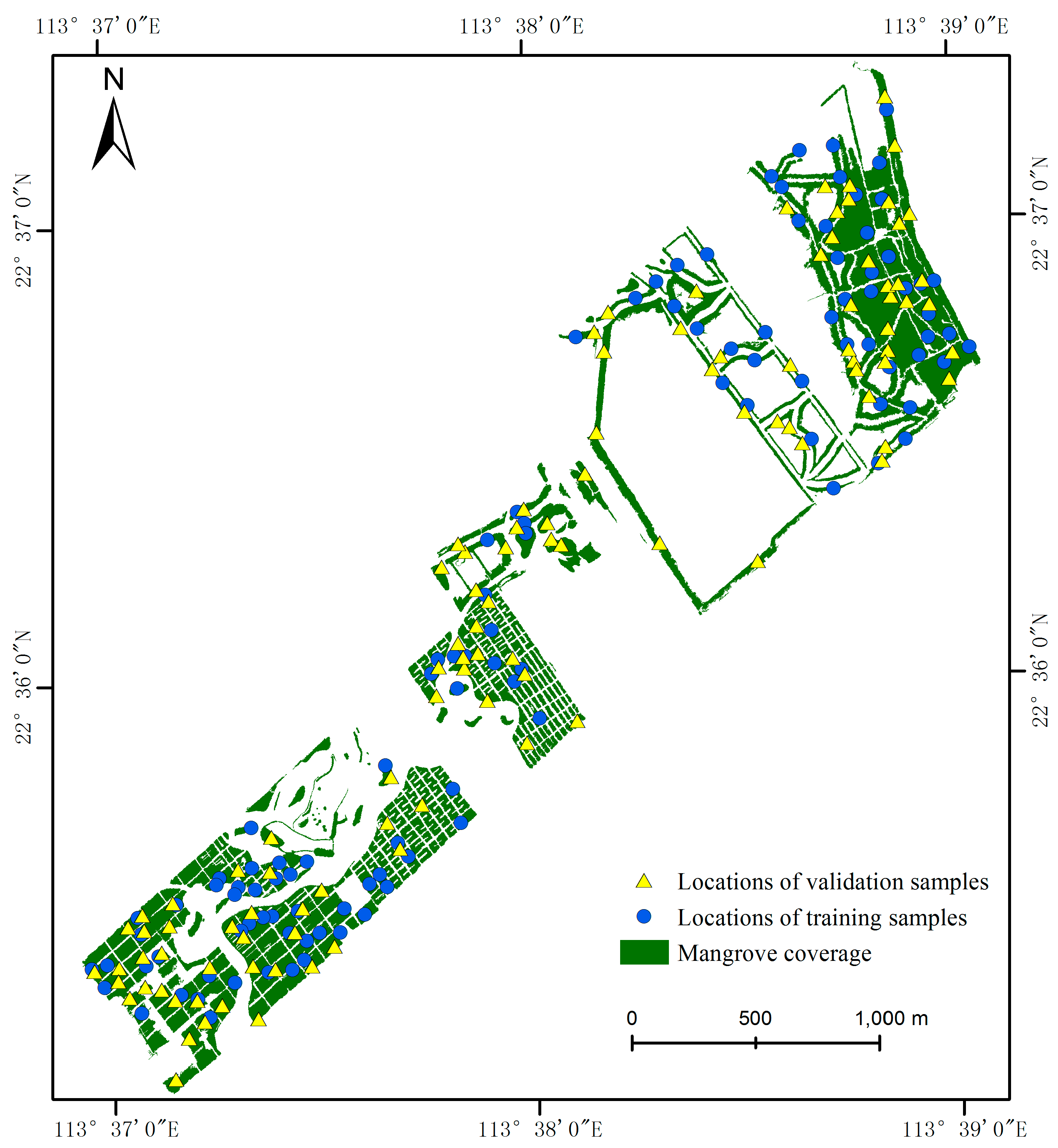
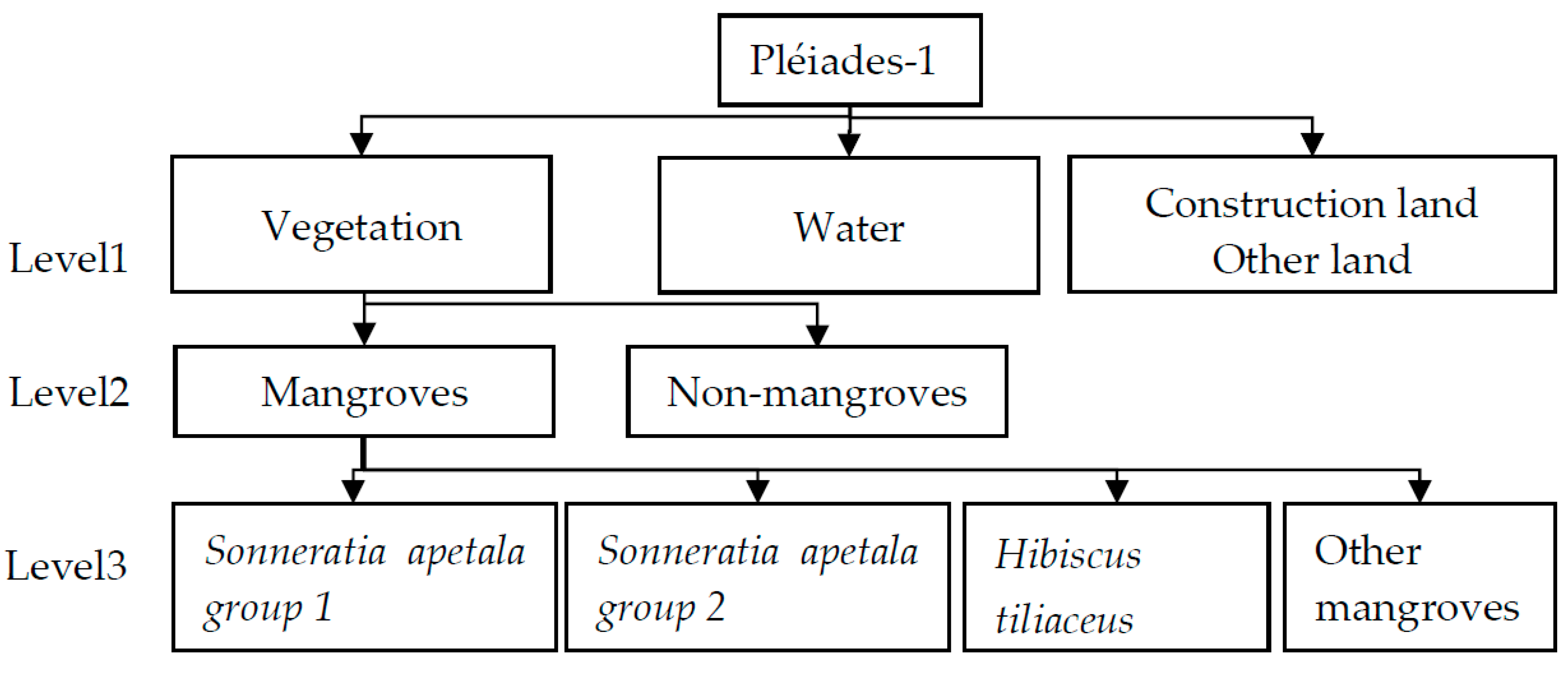
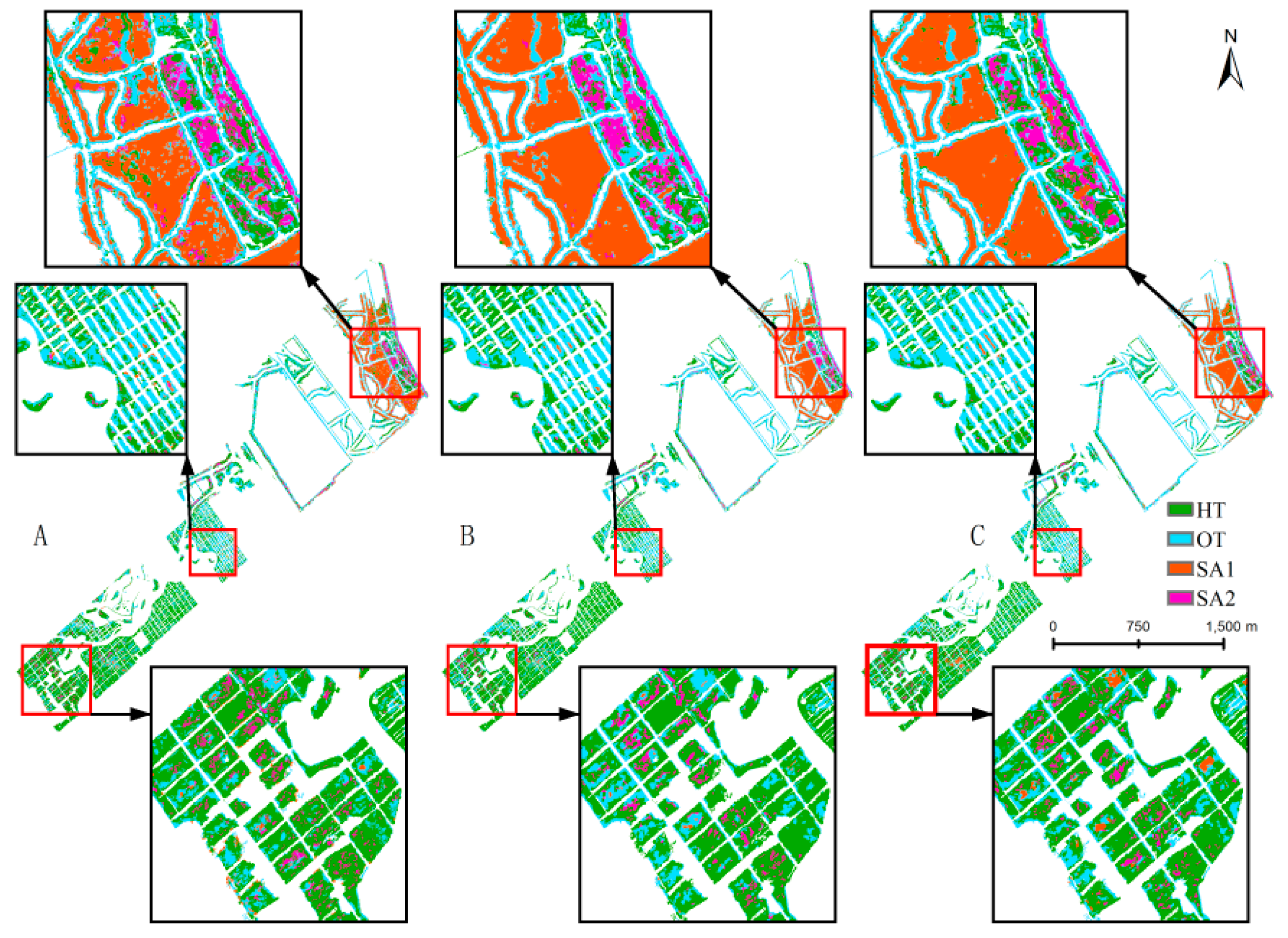
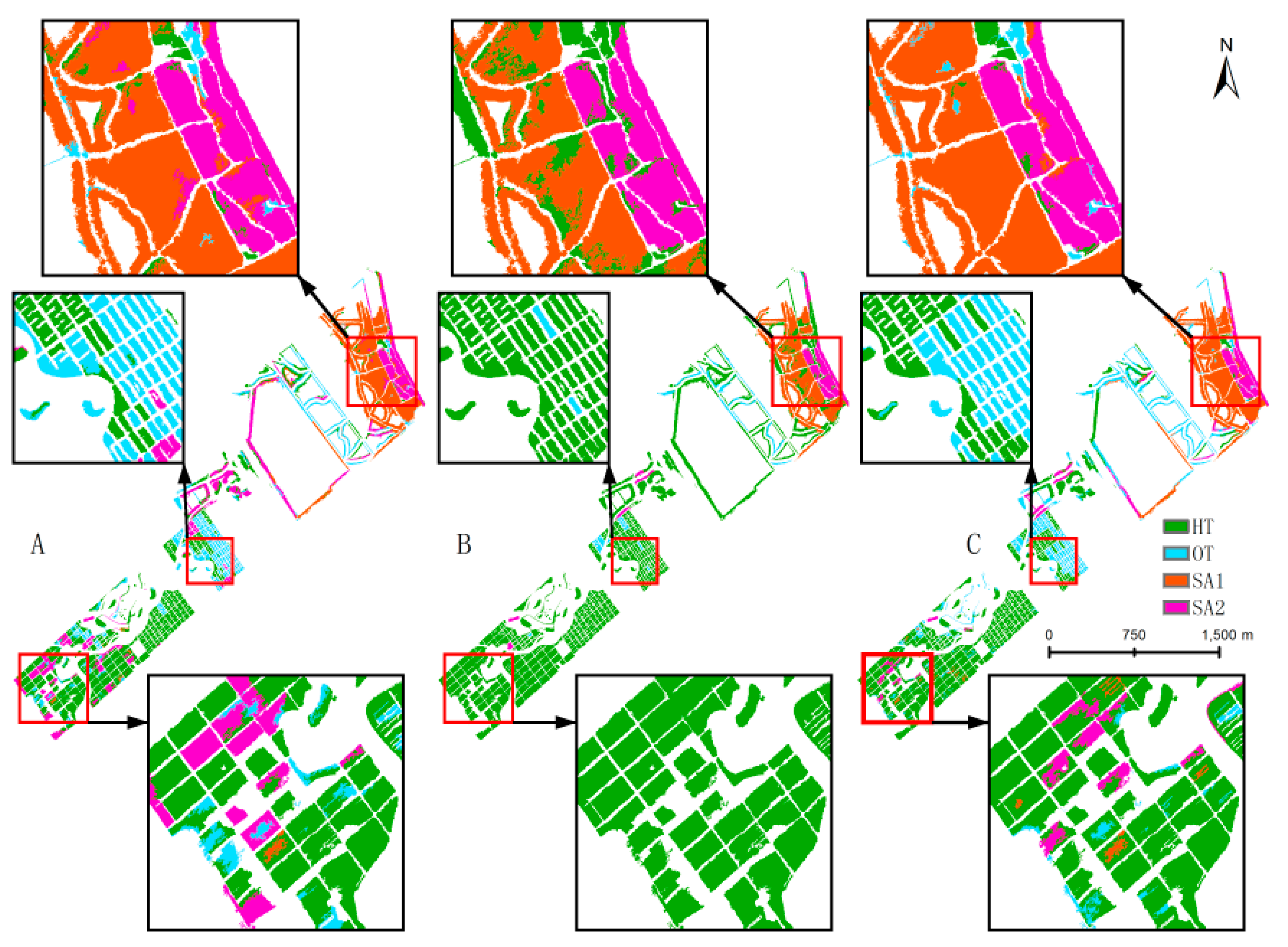
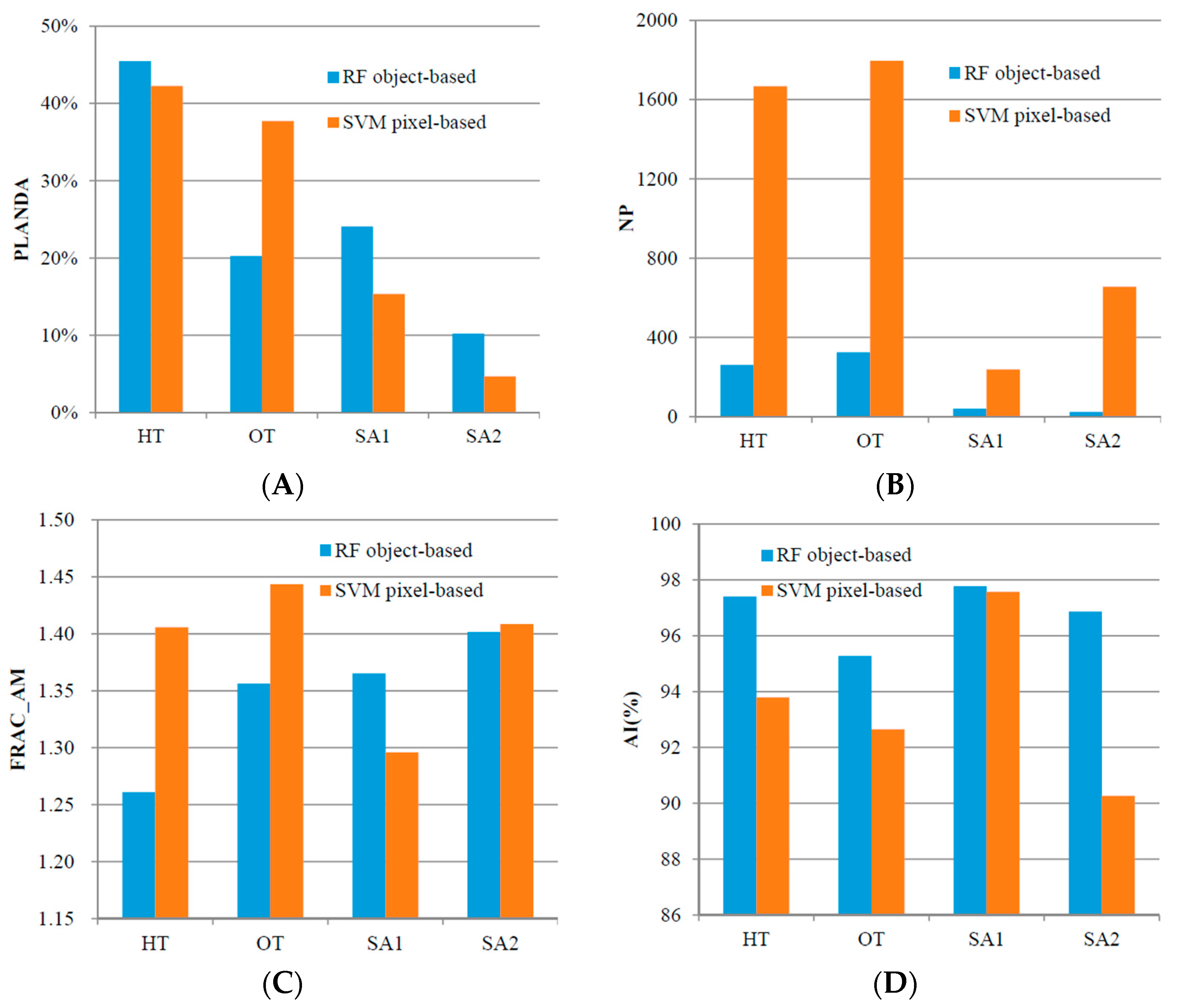
| Species | Training Samples (>25 m2 or 100 Pixel) | Validation Samples (Center Point) |
|---|---|---|
| Sonneratia apetala group 1 | 25 | 24 |
| Sonneratia apetala group 2 | 14 | 20 |
| Hibiscus tiliaceus | 47 | 45 |
| Other mangroves | 25 | 19 |
| All Samples | 111 | 108 |
| Pixel-Based, Decision Tree | Object-Based, Decision Tree | ||||||||||||
| SA1 | SA2 | HT | OT | Sum | Ua | SA1 | SA2 | HT | OT | Sum | Ua | ||
| SA1 | 17 | 0 | 1 | 0 | 18 | 94.44% | SA1 | 21 | 1 | 0 | 1 | 23 | 91.30% |
| SA2 | 2 | 7 | 3 | 2 | 14 | 50.00% | SA2 | 2 | 14 | 8 | 2 | 26 | 53.85% |
| HT | 2 | 7 | 33 | 5 | 47 | 70.21% | HT | 0 | 0 | 32 | 3 | 35 | 91.43% |
| OT | 2 | 5 | 8 | 14 | 29 | 48.28% | OT | 0 | 4 | 5 | 15 | 24 | 62.50% |
| Sum | 23 | 19 | 45 | 21 | 108 | Sum | 23 | 19 | 45 | 21 | 108 | ||
| Pa | 73.91% | 36.84% | 73.33% | 66.67% | Pa | 91.30% | 73.68% | 71.11% | 71.43% | ||||
| Kappa: | 51.62% | Oa: | 65.74% | Kappa: | 67.20% | Oa: | 75.93% | ||||||
| Pixel-Based, Support Vector Machine | Object-Based, Support Vector Machine | ||||||||||||
| SA1 | SA2 | HT | OT | Sum | Ua | SA1 | SA2 | HT | OT | Sum | Ua | ||
| SA1 | 21 | 0 | 0 | 0 | 21 | 100% | SA1 | 21 | 0 | 0 | 0 | 21 | 100.00% |
| SA2 | 1 | 9 | 1 | 1 | 12 | 75.00% | SA2 | 1 | 6 | 0 | 0 | 7 | 85.71% |
| HT | 0 | 2 | 38 | 2 | 42 | 90.48% | HT | 1 | 13 | 45 | 14 | 73 | 61.64% |
| OT | 1 | 8 | 6 | 18 | 33 | 54.55% | OT | 0 | 0 | 0 | 7 | 7 | 100.00% |
| Sum | 23 | 19 | 45 | 21 | 108 | Sum | 23 | 19 | 45 | 21 | 108 | ||
| Pa | 91.30% | 47.37% | 84.44% | 85.71% | Pa | 91.30% | 31.58% | 100.00% | 33.33% | ||||
| Kappa: | 71.61% | Oa: | 79.63% | Kappa: | 58.88% | Oa: | 73.15% | ||||||
| Pixel-Based, Random Forest | Object-Based, Random Forest | ||||||||||||
| SA1 | SA2 | HT | OT | Sum | Ua | SA1 | SA2 | HT | OT | Sum | Ua | ||
| SA1 | 20 | 0 | 1 | 0 | 21 | 95.24% | SA1 | 22 | 1 | 0 | 1 | 24 | 91.67% |
| SA2 | 1 | 9 | 3 | 1 | 14 | 64.29% | SA2 | 1 | 10 | 0 | 0 | 17 | 90.90% |
| HT | 1 | 2 | 31 | 5 | 39 | 79.49% | HT | 0 | 4 | 43 | 6 | 47 | 81.13% |
| OT | 1 | 8 | 10 | 15 | 34 | 44.12% | OT | 0 | 4 | 2 | 14 | 20 | 70.00% |
| Sum | 23 | 19 | 45 | 21 | 108 | Sum | 23 | 19 | 45 | 21 | 108 | ||
| Pa | 86.96% | 47.37% | 68.89% | 71.43% | Pa | 95.65% | 52.63% | 95.56% | 66.67% | ||||
| Kappa: | 57.80% | Oa: | 69.44% | Kappa: | 74.66% | Oa: | 82.40% | ||||||
| McNemar’s chi-Squared | p-Value | |
|---|---|---|
| DT Pixel-based vs. DT Object-based | 3.4571 | 0.0630 |
| SVM Pixel-based vs. SVM Object-based | 1.8148 | 0.1779 |
| RF Pixel-based vs. RF Object-based | 9.0000 * | 0.0027 * |
| McNemar’s chi-Squared | p-Value | |
|---|---|---|
| DT Pixel-based vs. SVM Pixel-based | 9.0000 * | 0.0027 * |
| DT Pixel-based vs. RF Pixel-based | 0.3333 | 0.5637 |
| SVM Pixel-based vs. RF Pixel-based | 6.5455 * | 0.0105 * |
| McNemar’s chi-Squared | p-Value | |
|---|---|---|
| DT Object-based vs. SVM Object-based | 0.2903 | 0.5900 |
| DT Object-based vs. RF Object-based | 2.8824 | 0.0896 |
| SVM Object-based vs. RF Object-based | 7.1429 * | 0.0075 * |
| LID | TA | NP | AREA_MN | LPI | FRAC_AM | CONTAG | SHDI |
|---|---|---|---|---|---|---|---|
| RF object-based | 133.52 | 650 | 0.2054 | 8.00 | 1.3197 | 52.06 | 1.26 |
| SVM pixel-based | 133.52 | 4356 | 0.0307 | 2.62 | 1.4033 | 50.61 | 1.16 |
© 2018 by the authors. Licensee MDPI, Basel, Switzerland. This article is an open access article distributed under the terms and conditions of the Creative Commons Attribution (CC BY) license (http://creativecommons.org/licenses/by/4.0/).
Share and Cite
Wang, D.; Wan, B.; Qiu, P.; Su, Y.; Guo, Q.; Wu, X. Artificial Mangrove Species Mapping Using Pléiades-1: An Evaluation of Pixel-Based and Object-Based Classifications with Selected Machine Learning Algorithms. Remote Sens. 2018, 10, 294. https://doi.org/10.3390/rs10020294
Wang D, Wan B, Qiu P, Su Y, Guo Q, Wu X. Artificial Mangrove Species Mapping Using Pléiades-1: An Evaluation of Pixel-Based and Object-Based Classifications with Selected Machine Learning Algorithms. Remote Sensing. 2018; 10(2):294. https://doi.org/10.3390/rs10020294
Chicago/Turabian StyleWang, Dezhi, Bo Wan, Penghua Qiu, Yanjun Su, Qinghua Guo, and Xincai Wu. 2018. "Artificial Mangrove Species Mapping Using Pléiades-1: An Evaluation of Pixel-Based and Object-Based Classifications with Selected Machine Learning Algorithms" Remote Sensing 10, no. 2: 294. https://doi.org/10.3390/rs10020294
APA StyleWang, D., Wan, B., Qiu, P., Su, Y., Guo, Q., & Wu, X. (2018). Artificial Mangrove Species Mapping Using Pléiades-1: An Evaluation of Pixel-Based and Object-Based Classifications with Selected Machine Learning Algorithms. Remote Sensing, 10(2), 294. https://doi.org/10.3390/rs10020294







